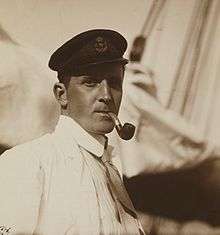Bjørn Helland-Hansen
| Bjørn Helland-Hansen | |
|---|---|
 Bjørn Helland-Hansen | |
| Born |
October 16, 1877 Christiania (now Oslo) |
| Died |
September 7, 1957 (aged 79) Bergen |
| Residence | Norway |
| Nationality | Norwegian |
| Citizenship | Norwegian |
| Known for |
Atlantic Ocean "Helland-Hansen Photometer |
| Children | Eigil Helland-Hansen |
| Awards |
Alexander Agassiz Medal (1933) Vega Medal (1941) |
| Scientific career | |
| Fields | oceanography |
| Institutions | Geophysical Institute, University of Bergen |
Bjørn Helland-Hansen (16 October 1877 – 7 September 1957) was a Norwegian pioneer in the field of modern oceanography. He studied the variation patterns of the weather in the northern Atlantic Ocean and of the atmosphere. [1]
He studied both medicine and physics at the University of Christiania (now University of Oslo). He developed the "Helland-Hansen Photometer" in 1910, which was carried on board Michael Sars. It was operated for the first time close to the Azores at a depth between 500 and m. In 1915 he became Professor of oceanography at the Bergen Museum, and in 1917 director of the Geophysical Institute, University of Bergen.[2]
In 1933 he was awarded the Alexander Agassiz Medal. From 1946 to 1948, Helland-Hansen was President of the International Union of Geodesy and Geophysics (IUGG). He was a member of the Prussian Academy of Sciences and a member of the Member of the Academy of Sciences of the German Democratic Republic (DDR).
Helland-Hansen trained Alexander Kuchin, the Russian oceanographer who went to Antarctica with Roald Amundsen. An island in the Russian Arctic, east of the Geiberg Islands, has been named Gellanda-Gansena after Helland-Hansen.

References
- ↑ Knut Barthel. "Bjørn Helland-Hansen". Store norske leksikon. Retrieved January 1, 2017.
- ↑ Herman G. Gade. "Bjørn Helland-Hansen". Norsk biografisk leksikon. Retrieved January 1, 2017.
External links
- Bjørn Helland-Hansen in the German National Library catalogue